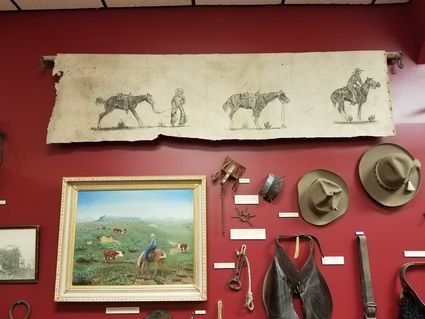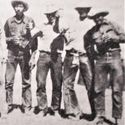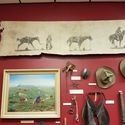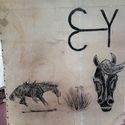Native cowboy artist used materials at hand to make unique art
January 27, 2021

The images on this canvas were painted by native cowboy artist Walter J. Brown. The canvas in the Blaine County Museum is one of two pieces painted by Brown, probably sometime in the 1950's. Brown died in 1994 at the age of 80.
Blaine County Museum Curator/Manager Samantha French asked me recently what I knew about a piece of art on canvas that once covered a chuckwagon on the Miller Brothers ranch. The piece of canvas has hand drawn cowboy/horse images and is displayed in the museum with other items related to ranching. I'd not given much thought to the piece during prior visits to the museum but when I really studied the canvas I saw a piece of folk art illustrated with authentic, detailed cowboy imagery.
The curator learned via Jim Halseth, who worked for Miller Brothers and wrote about working as a cowboy on the huge ranch, that the piece was drawn by Walter J. Brown. Brown, from the Hays area, worked as a cowboy and also was a camp cook when the crew moved cattle to summer pasture on Fort Belknap. Samantha French told of another similar canvas owned by Leah Miller and Leah's plan to give that canvas to the museum. Here's some of what I discovered about the artist and his work.
The artist and the two canvas pieces
Walter J. Brown was born in 1914 near Hays. Russell Cebulski, now living in Malta, worked with Walter Brown as a cowboy, noting, "I started working for the Miller Brothers in 1949 and Walter came to work as a cowboy and sometime cook shortly after I started." Jim Halseth's book about the E-Y (Miller Brothers' brand) cowboys has several photos of Walter driving the chuckwagon (mess wagon) and working as a cook. Walter's brother, Bill, is also pictured driving the 'bed wagon.' A younger brother, Joe, helped with the spring drive while still a high school student.
Cebulski said Walter did artwork on the chuckwagon's canvas while working and cooking away from ranch headquarters. Russell Cebulski recalled, "We always had a hind quarter of beef and a hundred pound sack of potatoes. We had beef and potatoes for every meal."
What remains of the artwork are two pieces of canvas. The canvas in the museum (see photo) is about six feet by one and a half feet and was a gift from Mike Tilleman. Mike's son, Craig, described how his father took the canvas as a part of a payment for a new pickup. I spoke with Jim Smock, the pickup buyer from Great Falls, who brought the canvas to Tilleman Motors in 2005.
Smock explained some background: "In 2005 I was driving a truck for a construction company. My boss, Delbert Herron, had a rummage sale at his house and I bought an old blue trunk that no one else seemed interested in." Asked what was in the trunk Smock's boss said, "Some pictures done by a native sheepherder up south of Chinook." A few months later Smock opened the trunk and was surprised to find a folded up canvas.
When he opened the canvas and saw the paintings Smock said, "I decided to take it up to Havre to show Mike Tilleman at his car dealership. I figured he would know something about it. Mike looked at the canvas and said he knew who painted it." Interestingly, Mike's son, Craig, said his dad thought Clarence Cuts the Rope (a well-known Blaine County artist) painted the canvas. Mike offered Jim Smock $500 credit toward the purchase of the Chevy pickup. Tilleman hung the canvas in the showroom until a remodeling project necessitated its removal. One day Leah Miller was in the dealership. Knowing her husband, Max, was part of the Miller family, Mike gave Leah the canvas saying, "Give this to the county museum, that's where it should be."
Leah Miller still has the other canvas Walter Brown painted on the chuckwagon. That piece is about six feet by four feet with similar horse/cowboy images plus the E-Y brand. That part of the canvas was given to her late husband Max by his uncle Erwin, the son of Henry Miller who was one of the original Miller Brothers. Leah is giving that canvas to the museum once a suitable display for both canvases can be determined.
Doing art
Joe Brown's wife, Susie, said of her brother-in-law Walter, "Oh, he was an artist, he drew on everything." Russell Cebulski, a fellow cowboy, described Walter Brown's drawing technique as unusual. "If he was drawing a cowboy on a bucking bronc, he might do the cowboy's hat first,"
Russell explained, "then draw the horse's head or rear end, then the cowboy's boot. You could never tell what the drawing was until it was completed." In the case of the canvas on the chuckwagon, the actions of his fellow cowboys appear to have inspired the images he drew.
Most native folk artists use materials and tools at hand and Walter Brown was no exception. Russell Cebulski said, "Walter did all the drawings on the chuckwagon's canvas using wagon axle grease and his fingers." That didn't seem possible but Walter's younger brother, Joe, verified, "Walter told me one time he did all the drawings on the canvas with grease and his finger." Walter confided to Cebulski at some point that he'd like to do art as a career and wanted Cebulski to be his agent. "The problem, " Walter told Cebulski, "is people would sooner buy me $50 worth of drinks than pay me $40 for a piece of my art."
Others who knew Walter agreed he was "a good artist and was always drawing on everything." I wondered if other pieces of his work remained. Younger brother Joe said, "It would not surprise me if he drew on the walls of some of the places where he worked away from the main ranch, like at Wilson Desert. Walter would winter there, relying on Maida McCartney to alert him during her "Chinook Hour" radio show when his supplies would be delivered." Joe added, "I'm not sure if any of the buildings still survive out there."
The rest of the story

This is a canvas from a chuckwagon with images done by native artist Walter J. Brown. Brown was a cowboy and sometime camp cook for Miller Brothers (the brand is the Miller brand). This piece of canvas was given to Max Miller by his uncle Erwin, the son of Henry Miller, one of the founders of the historical Blaine County ranching operation. Brown used wagon axle grease and his finger to draw the images on the canvas.
Joe Brown believes Walter left Miller Brothers sometime in the late 1950's or early 1960's. Walter moved to Butte and worked as a miner until he retired. Per Joe, Walter's first wife was from Wyoming. "He met her while working down there," Joe explained, "and I remember them coming back to Montana to visit on holidays." Walter had two sons, one of whom is deceased.
Walter J. Brown died in 1994 at 80 years of age. After becoming ill he was brought back to Havre where he died in the hospital. Joe remembered "visiting him the day before he died." Joe's wife, Susie, told that some of the relatives arranged for a horse drawn wagon to transport Walter's body to the Harlem Cemetery for burial.
I still wonder about some aspects of Walter J. Brown's art work. For example, are there still missing pieces that were a part of the canvas on the chuckwagon? It would be interesting if other pieces showed up to add to the existing drawings. And, are there other pieces of work by Walter still in the area? And how did that guy in Great Falls initially acquire the trunk with the painted canvas inside? Lastly, when will the two existing pieces be back together on display at the museum? As to the last question, if Samantha French and Leah Miller have their way, the pieces will be on display sooner than later.









